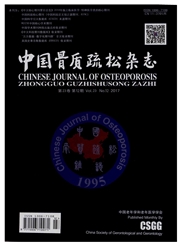

 中文摘要:
中文摘要:
目的检测外源性的BMSCs是否可向骨缺损处迁移,Hoechest3342标记BMSCs,从而跟踪外源性BMSCs在体内的迁移,研究其归巢机制可行性。方法贴壁筛选提取大鼠BMSCs,培养至第三代,用Hoechst33342标记后,尾静脉回植于颅骨缺损的大鼠体内,14d后处死大鼠,取颅骨,切片,荧光显微镜下观察细胞迁移情况。主要观察指标:光学显微镜下观察不同时期细胞形态和表面抗原检测;荧光显微镜下观察Hoechst33342标记后细胞形态,以及细胞增殖率;组织切片上Hoechst33342标记的阳性细胞。结果筛选纯化的BMSCs呈均一的成纤维细胞样,贴壁生长,以长梭形为主。CD45阴性,CD44、CD90均呈阳性表达;组织切片上可见Hoechst33342标记大鼠的BMSCs。结论外源性的BMSCs可向骨缺损处迁移;Hoechst33342可以标记BMSCs,从而跟踪外源性BMSCs在体内的迁移,进而研究其归巢机制。
 英文摘要:
英文摘要:
Objective To detect the migration of exogenous bone mesenchymal stem cells (BMSCs) in the bone defective site and to research the feasibility of homing mechanism through tracing the migration of exogenous BMSCs labeled with Hoechest 33342 in vivo. Methods Rat BMSCs were extracted and screened using the adherence method. After cultured to the third generation, BMSCs were labeled with Hoechst 33342 and then replanted in the rats with skull defect through tail vein. Rats were killed after 14 days and the skull were sliced to observe the cell migration under fluorescence microscopy. The main observed indexes included cell morphology and surface antigen detection of different periods using light microscopy, morphology of cells labeled with Hoechst 33342 and cell proliferation under fluorescence microscopy, and the positive cells labeled by Hoechst 33342 in tissue sections. Results Purified BMSCs showed homogeneous fibroblast-like morphology, mainly with long fusiform and adherent growth. CD45 was negative in these cells. However, CD44 and CD90 were positive. BMSCs labeled by Hoechst 33342 were observed in the sections. Conclusion Exogenous BMSCs can migrate to the bone defect site in vivo. Migration of exogenous BMSCs can be traced using Hoechst 33342 to research the homing mechanism.
 同期刊论文项目
同期刊论文项目
 同项目期刊论文
同项目期刊论文
 期刊信息
期刊信息
